Shipley Park - Miller-Mundy
Memories
w/e 07 January 2007
All
this week's pictures were taken with a Kodak DX6490

Part 1 - Introduction & The
Four Mines
For a couple of weeks during September 2006, the Borough Councils
of Erewash and Amber Valley jointly hosted a Walking Festival
under the title of "Autumn Footprints". The event included
a number of daily walks across the two administrative areas and
was launched on Saturday 9th September at the Visitor Centre
in Shipley Country Park. The opening ceremony attended by 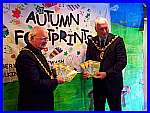 both the respective
Mayors (see left) was followed by a three mile circular walk
through the park entitled "Miller-Mundy Memories".
This was advertised as a gentle walk with information on the
heritage of the Country Park, looking at the influence of the
Miller-Mundy family on the landscape to be seen today and it
was scheduled to last two hours. both the respective
Mayors (see left) was followed by a three mile circular walk
through the park entitled "Miller-Mundy Memories".
This was advertised as a gentle walk with information on the
heritage of the Country Park, looking at the influence of the
Miller-Mundy family on the landscape to be seen today and it
was scheduled to last two hours.
The optimum number for the walk was twenty five but such was
the interest that more than forty people from those that attended
the opening decided to partake in the walk too. Whilst this was
not a problem in itself, it did mean that it took a little longer
to assemble the party at the various stops along the route where
the leader, Gary Wain of Groundwork Erewash Valley provided some
little gems of information not readily available elsewhere. It
also meant that he was not able to divulge all of the knowledge
he had at his disposal but he was kind enough to provide me with
a copy of his notes at the conclusion of the walk. I resolved
then to retrace the steps of the walk using Gary's notes as a
basis for this series.
Whilst it would be quite easy to walk the entire route in the
stipulated two hours I 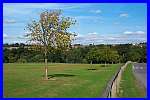 intend
to take a more leisurely approach and visit the park at monthly
intervals to compile this series. Many of the images yet to be
captured at the beginning of 2007 will be of views familiar to
anyone conversant with the area like the one shown here on the
right but there will be some shots of details that could be and,
if my experience is anything to go by, have been overlooked without
some knowledgeable person to point them out. That is why I am
indebted to Gary Wain for his research into the history of the
Miller-Mundy family and the impact it had on the area. intend
to take a more leisurely approach and visit the park at monthly
intervals to compile this series. Many of the images yet to be
captured at the beginning of 2007 will be of views familiar to
anyone conversant with the area like the one shown here on the
right but there will be some shots of details that could be and,
if my experience is anything to go by, have been overlooked without
some knowledgeable person to point them out. That is why I am
indebted to Gary Wain for his research into the history of the
Miller-Mundy family and the impact it had on the area.
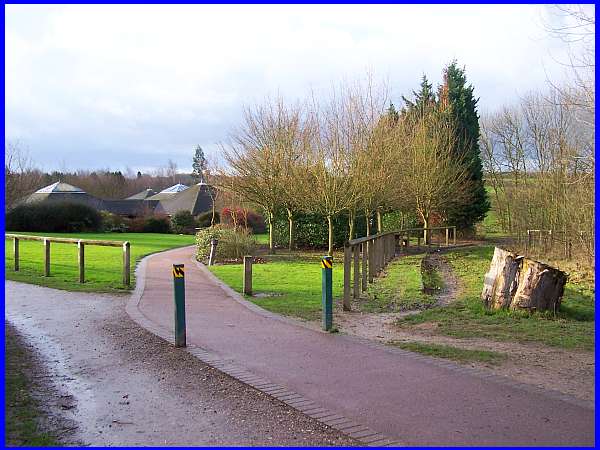
The walk starts and finishes at the Visitor Centre but before
we set off, we should consider some of the things that will become
apparent as we move around the park. The Miller-Mundy family
owned the Shipley Estate for over two hundred years from 1712
until 1922 and during our walk we shall see evidence of railways,
canals, collieries, estate buildings as well as the site of their
former residence at Shipley Hall. It is also worthwhile at this
point to consider the Shipley estate's history prior to Miller-Mundy
times.
|
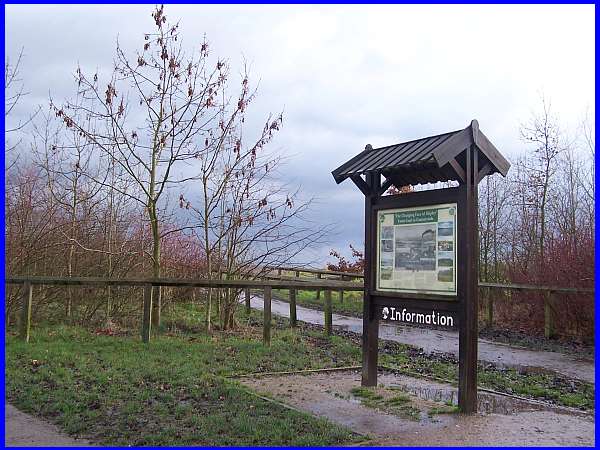
The Information Board which marked the assembly point for the
walk at the corner of the car park contains a potted history
and shows a number of photographs from more recent times. Gary's
notes add to the information on the board which says that the
Shipley Estate is an ancient manor mentioned in   the Domesday Book. It was given
to Gilbert of Ghent by his uncle William the Conqueror as a reward
for his loyalty as a Knight. Prior to that it had been in the
ownership of the Danish Lord Ulf Fensic. Ownership passed from
Gilbert to his steward, Robert de Muskham and again in 1215 to
Robert le Vavosour again in return for service as a Knight. In
1280 the estate passed by marriage to the Strelley family of
Nottingham who held it for over three hundred and twenty years
until 1608. The name of Strelley is perpetuated today in the
Nottinghamshire village a few miles away. It was during their
occupancy in the mid 1500s that coal mining in the shape of shallow
drift mines and bell pits began to play an increasingly important
part in shaping the landscape at Shipley and providing an income
for the owners. By 1722 the mining operations were being run
by coalmasters but after 1765 the Miller-Mundy family took over
running the mines themselves. The Miller-Mundys owned four mines
and by the early 1900s over 100,000 tonnes of coal were being
extracted each year. the Domesday Book. It was given
to Gilbert of Ghent by his uncle William the Conqueror as a reward
for his loyalty as a Knight. Prior to that it had been in the
ownership of the Danish Lord Ulf Fensic. Ownership passed from
Gilbert to his steward, Robert de Muskham and again in 1215 to
Robert le Vavosour again in return for service as a Knight. In
1280 the estate passed by marriage to the Strelley family of
Nottingham who held it for over three hundred and twenty years
until 1608. The name of Strelley is perpetuated today in the
Nottinghamshire village a few miles away. It was during their
occupancy in the mid 1500s that coal mining in the shape of shallow
drift mines and bell pits began to play an increasingly important
part in shaping the landscape at Shipley and providing an income
for the owners. By 1722 the mining operations were being run
by coalmasters but after 1765 the Miller-Mundy family took over
running the mines themselves. The Miller-Mundys owned four mines
and by the early 1900s over 100,000 tonnes of coal were being
extracted each year.
|

This map on another information board is about horse riding in
the park but serves to show the location of the four mines, the
sites of which are pictured below. Before we start the walk proper
we'll take a closer look at the sites of the four mines as they
appear today.
|
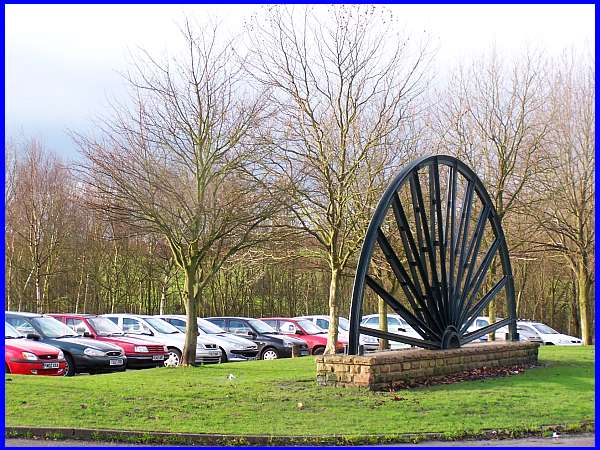
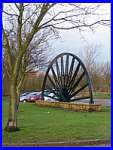 The mining
rights were sold by the Miller-Mundys in 1920 to the Shipley
Colliery Company who mined until 1947 when the industry was nationalised
and taken over by the National Coal Board (NCB). The NCB continued
operations until the 1960s but two hundred and fifty years of
deep mining came to an end in 1966 with the closure of the last
of the four mines when Coppice Colliery closed as it had become
uneconomic. In November of 1970, the NCB began opencast mining
which continued until 1974. For another two years, work continued
to contour the area and restore it by seeding fields and meadows,
planting trees and constructing facilities for the public. Phase
1 of the park was opened on May 26th 1976 and the visitor centre
for Shipley Country Park was built on the site of Coppice Colliery
in 1984. The site is now commemorated on the car park by this
structure made from part of a winding wheel . The mining
rights were sold by the Miller-Mundys in 1920 to the Shipley
Colliery Company who mined until 1947 when the industry was nationalised
and taken over by the National Coal Board (NCB). The NCB continued
operations until the 1960s but two hundred and fifty years of
deep mining came to an end in 1966 with the closure of the last
of the four mines when Coppice Colliery closed as it had become
uneconomic. In November of 1970, the NCB began opencast mining
which continued until 1974. For another two years, work continued
to contour the area and restore it by seeding fields and meadows,
planting trees and constructing facilities for the public. Phase
1 of the park was opened on May 26th 1976 and the visitor centre
for Shipley Country Park was built on the site of Coppice Colliery
in 1984. The site is now commemorated on the car park by this
structure made from part of a winding wheel .
|
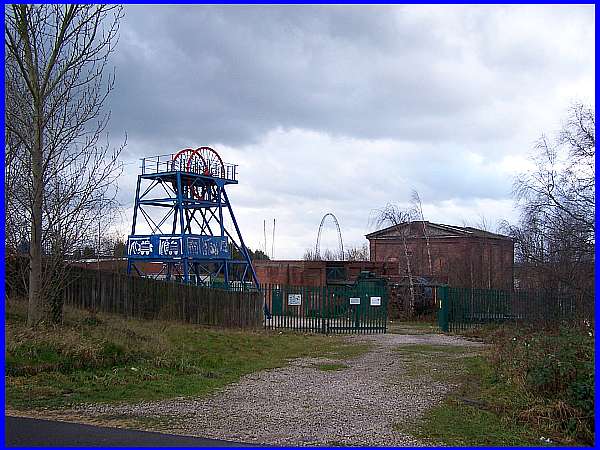
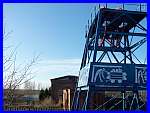 Woodside
Colliery was also closed as being uneconomic but this was in
1961, five years before Coppice's demise. Some old colliery buildings
still stand adjacent to the American Adventure Theme Park at
the Woodside Colliery site which is now marked by a lasting memorial
in the form of replica headstocks, one third the height of the
originals but topped by the original winding wheels. As I was
preparing this page this week, it was announced following a "period
of difficult trading" that the Theme Park is to close. Their
website boasts "Where The Fun Never Stops" - it has
now! Woodside
Colliery was also closed as being uneconomic but this was in
1961, five years before Coppice's demise. Some old colliery buildings
still stand adjacent to the American Adventure Theme Park at
the Woodside Colliery site which is now marked by a lasting memorial
in the form of replica headstocks, one third the height of the
originals but topped by the original winding wheels. As I was
preparing this page this week, it was announced following a "period
of difficult trading" that the Theme Park is to close. Their
website boasts "Where The Fun Never Stops" - it has
now!
|
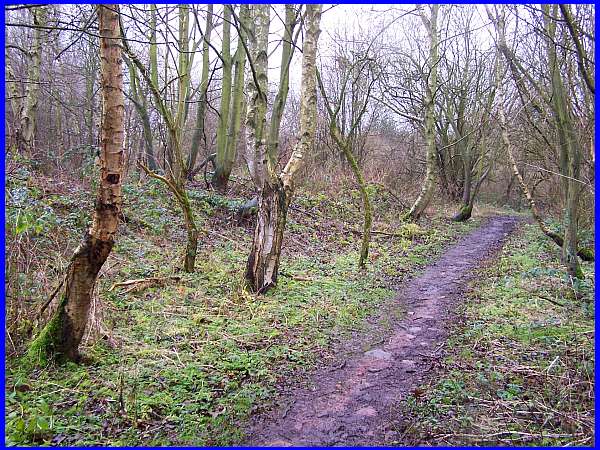
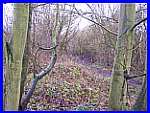 Between
the Coppice and Woodside sites is probably the least well-known
of the four sites - that of the Newcastle Colliery. Standing
to the north of and just off the Nutbrook Trail, backing on to
the housing estate at Marlpool, there is no lasting memorial
to betray the existence of the colliery save for the name of
Newcastle Plantation and a nearby pumping station. It is difficult
today to pinpoint the exact location of this colliery but I suspect
that the number of bricks and rubble in this footpath through
the coppice points to the positions of some of the now demolished
old colliery buildings. Between
the Coppice and Woodside sites is probably the least well-known
of the four sites - that of the Newcastle Colliery. Standing
to the north of and just off the Nutbrook Trail, backing on to
the housing estate at Marlpool, there is no lasting memorial
to betray the existence of the colliery save for the name of
Newcastle Plantation and a nearby pumping station. It is difficult
today to pinpoint the exact location of this colliery but I suspect
that the number of bricks and rubble in this footpath through
the coppice points to the positions of some of the now demolished
old colliery buildings.
|
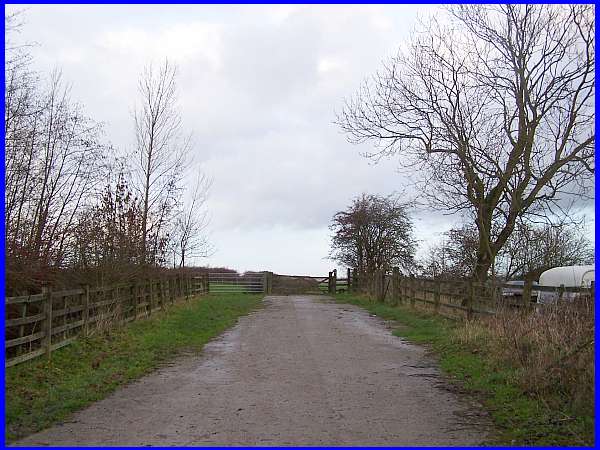
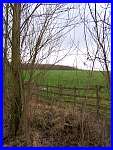 Likewise
at Mapperley Colliery, all evidence of the mining industry has
disappeared and sadly not even a marker exists as a memorial
to the hundreds of men who worked here and traipsed this road
on their way to work. All the buildings were demolished, the
shafts were capped, the area opencast and then restored with
new field boundaries. Trees were planted and it is to the distress
of many that the history and heritage here has been ignored by
those in positions of power and authority. Likewise
at Mapperley Colliery, all evidence of the mining industry has
disappeared and sadly not even a marker exists as a memorial
to the hundreds of men who worked here and traipsed this road
on their way to work. All the buildings were demolished, the
shafts were capped, the area opencast and then restored with
new field boundaries. Trees were planted and it is to the distress
of many that the history and heritage here has been ignored by
those in positions of power and authority.
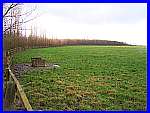 Like
other local people who had relatives who worked in the coal industry,
many members of my own and my wife's families were miners and
it is to them that I am dedicating this series. In the next part,
we'll return to the car park at the visitor centre and start
the walk to record for posterity some of those "Miller-Mundy
Memories" before the remaining evidence disappears altogether.
But before leaving the Mapperley Colliery site in the stillness
of a January afternoon it only takes a little imagination to
hear the ghostly footsteps of miners tramping along this road
on their way to work. Like
other local people who had relatives who worked in the coal industry,
many members of my own and my wife's families were miners and
it is to them that I am dedicating this series. In the next part,
we'll return to the car park at the visitor centre and start
the walk to record for posterity some of those "Miller-Mundy
Memories" before the remaining evidence disappears altogether.
But before leaving the Mapperley Colliery site in the stillness
of a January afternoon it only takes a little imagination to
hear the ghostly footsteps of miners tramping along this road
on their way to work.
Forward to Part 2
- To Harmer's Bridge
Use the Quick Links below to access other pages.
|